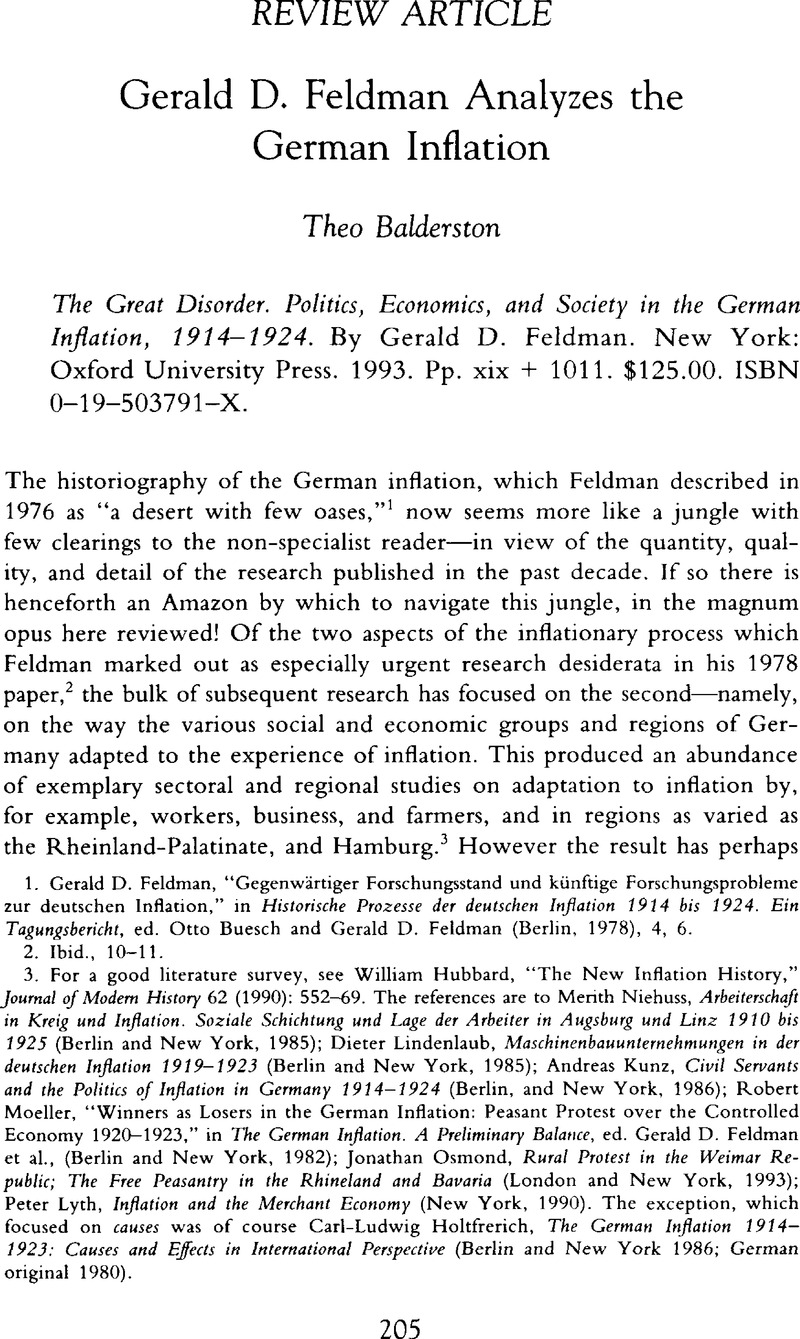Published online by Cambridge University Press: 16 December 2008

1. Feldman, Gerald D., “Gegenwärtiger Forschungsstand und künftige Forschungsprobleme zur deutschen Inflation,” in Historische Prozesse der deutschen Inflation 1914 bis 1924. Ein Tagungsbericht, ed. Buesch, Otto and Feldman, Gerald D. (Berlin, 1978), 4, 6.Google Scholar
2. Ibid., 10–11.
3. For a good literature survey, see Hubbard, William, “The New Inflation History,” Journal of Modern History 62 (1990): 552–69.CrossRefGoogle Scholar The references are to Niehuss, Merith, Arbeiterschaft in Kreig und Inflation. Soziale Schichtung und Lage der Arbeiter in Augsburg und Linz 1910 bis 1925 (Berlin and New York, 1985);Google ScholarLindenlaub, Dieter, Maschinenbauunternehmungen in der deutschen Inflation 1919–1923 (Berlin and New York, 1985);Google ScholarKunz, Andreas, Civil Servants and the Politics of Inflation in Germany 1914–1924 (Berlin, and New York, 1986);CrossRefGoogle ScholarMoeller, Robert, “Winners as Losers in the German Inflation: Peasant Protest over the Controlled Economy 1920–1923,” in The German Inflation. A Preliminary Balance, ed. Feldman, Gerald D. et al. , (Berlin and New York, 1982);Google ScholarOsmond, Jonathan, Rural Protest in the Weimar Republic; The Free Peasantry in the Rhineland and Bavaria (London and New York, 1993);Google ScholarLyth, Peter, Inflation and the Merchant Economy (New York, 1990).Google Scholar The exception, which focused on causes was of course Holtfrerich, Carl-Ludwig, The German Inflation 1914–1923: Causes and Effects in International Perspective (Berlin and New York 1986; German original 1980)CrossRefGoogle Scholar.
4. Feldman, “Gegenwärtiger Forschungsstand,” 18.
5. Ibid., 8f; see idem, Iron and Steel in the German Inflation 1916–1923 (Princeton, 1976), 280.Google Scholar The quotation is from Laursen, Karsten, and Pedersen, Joergen, The German Inflation 1918–1923 (Amsterdam, 1964), 123Google Scholar, where the authors also write, “The reason for this passivity [i.e. “lack of a policy”] was that according to the prevailing economics [sic] theory the only parameter of action was restriction of total demand by means of credit and fiscal policy.” See too 10, 70f., where wage policy is advanced as the policy parameter which contemporaries ignored.
6. Holtfrerich, German Inflation.
7. Webb, Steven B., Hyperinflation and Stabilization in Weimar Germany (New York, 1989); the reference is to p. 37.Google Scholar
8. Maier, Charles, “Die deutsche Inflation als Verteilungskonflikt: soziale Ursachen und Auswirkungen im internationalen Vergleich,” in Historische Prozesse, ed. Buesch, and Feldman, 329–42.Google Scholar Maier's theory emphasizes an inflationary consensus between capital and labor (p. 331); Costatino Bresciani-Turroni, in his classic, The Economics on Inflation. A Study of Currency Depreciation in Postwar Germany (London, 1937; Italian original 1931) argued (58f., 70, 100–5)Google Scholar that the distributional interests of business and of the wealthy prevented sound budgeting and played a large part in delaying stabilization.
9. Webb, Hyperinflation, 37, 76.
10. Bessell, Richard, Germany after the First World War (Oxford, 1993), 220ff.Google Scholar, has also recently emphasized the effects of the “postwar transition” on the “moral order.”